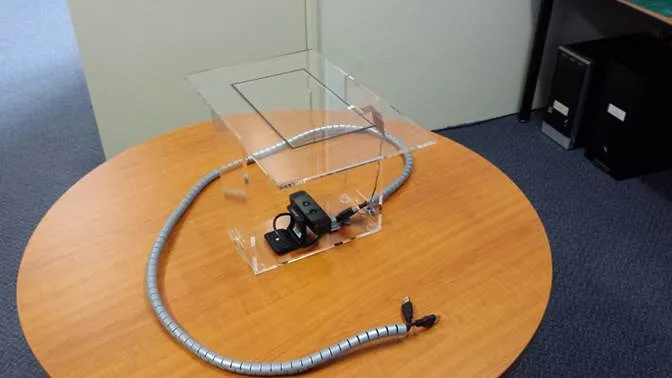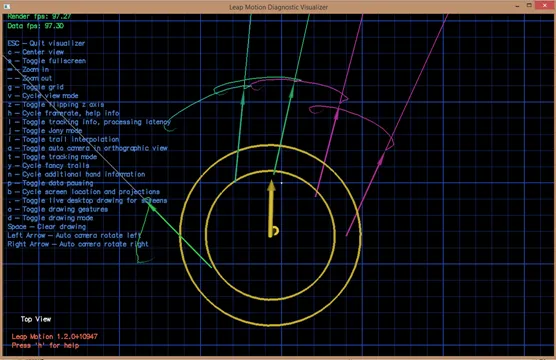May 2014 focused on transforming working prototypes into demonstration-ready systems while exploring new platforms for showcasing the visual touch concept.
Professional Prototype Completion
The acrylic frame prototypes reached production quality this month. After collecting the second iteration, final modifications were identified: vertical segments on both sides for added stability and cable management holes in the vertical segments. These refinements transformed the prototypes from functional experiments into presentation-worthy demonstration units.
Assembly of complete systems began with careful drilling and mounting of depth cameras to the stands. Silicon bumpers, protective covers, and cable management completed the physical builds. Three separate stands were configured: two with 3D sensors and one equipped with a Leap Motion sensor, each with protective transport covers. These multiple configurations allowed for comparative demonstrations of different sensor technologies.


The Code Signing Certificate Challenge
A significant technical obstacle emerged around Windows 8 Metro mode compatibility. For the application to function as a topmost overlay in both desktop and Metro modes, proper code signing was essential. Initial attempts with self-signed certificates created ongoing hassles that interrupted development flow.
The solution involved purchasing a proper code signing certificate from DigiCert. However, certificate installation proved unexpectedly complex. Using Firefox to download the certificate didn’t automatically install it to the Windows certificate store, requiring manual export in P12 format. Multiple signing attempts with signtool failed until discovering that providing the P12 file directly as a command-line option worked where certificate store references did not.
Additional complications arose from isolated storage configuration loading. The application displayed error dialogs when configuration files were missing, requiring code modifications to only show errors when files were actually available. These seemingly minor issues consumed significant development time but were necessary to achieve a polished demonstration experience across both Windows desktop and Metro environments.

Leap Motion V2 Evaluation
The Leap Motion platform received renewed attention with the release of Version 2 software. Testing revealed improved functionality, though hand recognition wasn’t consistently reliable—some sessions showed hands immediately while others required repositioning. Despite these inconsistencies, the Leap Motion’s unique capabilities warranted continued exploration as a parallel development track alongside the depth camera approach.
Experiments with the Leap Motion positioned in the prototype stands confirmed viability for the visual touch concept. The decision was made to develop a Leap-specific demonstration, leading to orders for additional hardware and explorations of Unity 3D integration. While Unity’s demo applications using Leap Motion showed promise, the built-in visualizer remained more responsive than the Unity implementations. Hand visualization assets discovered on the Unity Asset Store offered potential starting points for custom development.
Augmented Reality Exploration
Research into alternative demonstration platforms led to the Epson Moverio BT-200 AR glasses. The specifications were intriguing: the display equivalent to viewing an 80-inch screen at 15 feet, or roughly a 23-inch monitor at 4.5 feet. This could provide an immersive way to demonstrate visual touch concepts without requiring physical display hardware at demonstration sites.
Testing screen mirroring from Windows 8 to Android on the Moverio platform involved evaluating mirror applications. Avatron’s solution showed excessive lag that would detract from demonstrations. iDisplay proved more responsive on test Android devices, making it the preferred choice.
 Sourcing the BT-200 for Australian delivery presented challenges, with US purchase through a freight forwarder identified as a fallback option.
Sourcing the BT-200 for Australian delivery presented challenges, with US purchase through a freight forwarder identified as a fallback option.
Demonstration Infrastructure
Creating professional demonstration videos required addressing the presentation environment. An inexpensive TV trolley was ordered to enable video recording with clean backgrounds anywhere in the office space. This seemingly mundane equipment purchase represented recognition that communicating the innovation effectively required attention to production values, not just technical capability.
The month closed with the project positioned for effective demonstration across multiple platforms: professional acrylic prototypes, code-signed Windows applications compatible with both desktop and Metro modes, Leap Motion experimentation underway, and AR display options researched. The focus had shifted from proving technical feasibility to presenting the innovation in compelling ways to potential partners and investors.